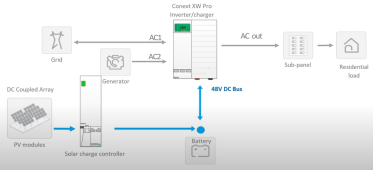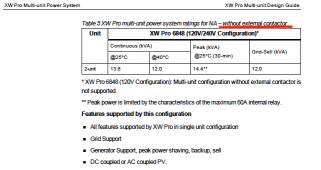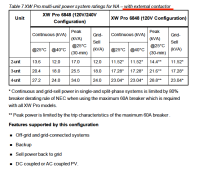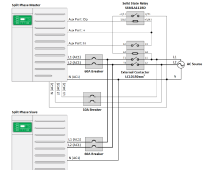LasseH
New Member
What system will be able to handle a full house of loads (including inductive loads)
Disclaimer:
- My house doesn't exceed 50A (240VAC) of continuous power.
- Main breaker is 200A, but I do not ever get close to that.
- My goal is to be completely off grid on a modern house using heat-pump HVAC, heat-pump water heater, heat-pump drier etc.
- Generator that turns on between of 20% and 60% state of charge using BMS features.
On one corner, we Have 1*Sol-Ark 15kWh
- Input breaker: 200A Double pole
- Output breaker: 200A Double pole
- With grid it has the ability to provide 28kWh(240VAC) to the house. (200A)
- With PV it has the ability to provide 15kWh(240VAC) to the house. (62.5A)
- With Battery it has the ability to provide 12kWh(240VAC) to the house. (50A)
- Battery terminal (DC) charge/discharge = 275A
- PV terminal (DC): - Max PV input is 19.5kW - 6.5kW per MPPT(max 2 strings - 3 MPPT's) - 500Voc Max - 26A max
- Idle consumption: 90W
- CEC Weighted Efficiency: 96.5% (97.5%)
- Battery charge efficiency: 96%
- Price is 8250$
On the other corner, we have 2*Dual Schneider Conext XW pro 6.8k:
- Input breaker: 2*60 Double pole = 120A
- Output breaker: 2*60 Double pole = 120A
- With PV, they has the ability to provide 13.6kWh(240VAC and inductive loads up to 24.000kWh Surge current.
- With Battery, they have the ability to provide 48VDC * 2*140A = 13.44kW
- Battery terminals (DC): Charge rate is 2*140A = 280A
- PV terminals (DC): - Max PV input is
- Idle consumption: 2*28W = 56W
- CEC Weighted Efficiency: 92.5% (Peak 95.7%)
- Battery charge efficiency: 98%
- Price is 2*3500$ = 7000$
- Charge controllers 2*1000$ = 2000$ (Schneider Conext MPPT 80 600)
Sol-ark:
- When grid tied, the The Sol-Ark seems more simple with less need for extras? (plug and play)
Schneider:
- Appear to be better all around when it comes to being completely off grid? (Superior surge current handling)
- Less big surge current faults that shut down the off-grid system because it can handle it better.
- Need a separate solar charge controller device to capture sunlight and charge batteries.

Main resource:
Other resource youtuber who talked down on Sol-ark and got the Schneider instead on his videos:
Disclaimer:
- My house doesn't exceed 50A (240VAC) of continuous power.
- Main breaker is 200A, but I do not ever get close to that.
- My goal is to be completely off grid on a modern house using heat-pump HVAC, heat-pump water heater, heat-pump drier etc.
- Generator that turns on between of 20% and 60% state of charge using BMS features.
On one corner, we Have 1*Sol-Ark 15kWh
- Input breaker: 200A Double pole
- Output breaker: 200A Double pole
- With grid it has the ability to provide 28kWh(240VAC) to the house. (200A)
- With PV it has the ability to provide 15kWh(240VAC) to the house. (62.5A)
- With Battery it has the ability to provide 12kWh(240VAC) to the house. (50A)
- Battery terminal (DC) charge/discharge = 275A
- PV terminal (DC): - Max PV input is 19.5kW - 6.5kW per MPPT(max 2 strings - 3 MPPT's) - 500Voc Max - 26A max
- Idle consumption: 90W
- CEC Weighted Efficiency: 96.5% (97.5%)
- Battery charge efficiency: 96%
- Price is 8250$
On the other corner, we have 2*Dual Schneider Conext XW pro 6.8k:
- Input breaker: 2*60 Double pole = 120A
- Output breaker: 2*60 Double pole = 120A
- With PV, they has the ability to provide 13.6kWh(240VAC and inductive loads up to 24.000kWh Surge current.
- With Battery, they have the ability to provide 48VDC * 2*140A = 13.44kW
- Battery terminals (DC): Charge rate is 2*140A = 280A
- PV terminals (DC): - Max PV input is
- Idle consumption: 2*28W = 56W
- CEC Weighted Efficiency: 92.5% (Peak 95.7%)
- Battery charge efficiency: 98%
- Price is 2*3500$ = 7000$
- Charge controllers 2*1000$ = 2000$ (Schneider Conext MPPT 80 600)
Sol-ark:
- When grid tied, the The Sol-Ark seems more simple with less need for extras? (plug and play)
Schneider:
- Appear to be better all around when it comes to being completely off grid? (Superior surge current handling)
- Less big surge current faults that shut down the off-grid system because it can handle it better.
- Need a separate solar charge controller device to capture sunlight and charge batteries.

Main resource:
Other resource youtuber who talked down on Sol-ark and got the Schneider instead on his videos:
Attachments
Last edited:






